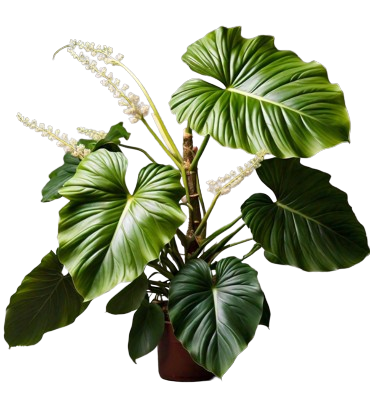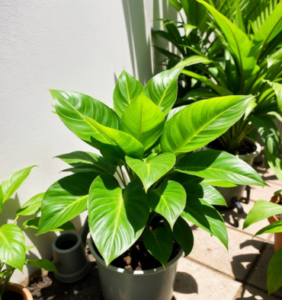Introduction
Philodendrons are among the most cherished tropical houseplants, beloved for their lush foliage and ease of care. These Aroid plants, hailing from the Araceae family, have found a special place in homes and offices worldwide. In this Philodendron care guide for beginners, we will delve into the fascinating world of Philodendrons, exploring their botanical characteristics, care requirements, and the numerous benefits they offer
What is Philodendron?
Philodendron is a genus of flowering plants that originated in the rainforests of Central and South America. The name “Philodendron” is derived from Greek, meaning “love tree,” a testament to their climbing plants’ nature and heart-shaped leaves. Historically, these plants have been admired for their beauty and versatility, often used to adorn homes and public spaces.
The Araceae Family
The arum family, or Araceae classification, has over 100 genera and over 3,750 species. Members of this family are usually identified by the architecture of their spathe and spadix flowers.
Among the notable members of the Araceae family are Anthurium, Philodendron, and Peace lily (Spathiphyllum).
Types of Philodendrons
Climbing Philodendrons
such as Philodendron hederaceum (Heartleaf Philodendron), are known for their vining growth habit. They thrive when given support structures like trellises or moss poles to climb.
Non-Climbing Philodendrons
Non-climbing Philodendrons, like Philodendron bipinnatifidum, grow more upright or sprawling. These plants do not require support and can be used as striking standalone specimens.
Popular Philodendron Varieties
Let’s explore some of the most popular Philodendron varieties and their unique features
Philodendron hederaceum
Also known as the Heartleaf Philodendron, this variety is famous for its heart-shaped leaves and vining growth habit. It’s an excellent choice for beginners due to its resilience and adaptability.
Philodendron erubescens
This species, often called the Red Emerald Philodendron, boasts striking red stems and glossy green leaves. It adds a pop of color to any indoor garden.
Philodendron bipinnatifidum
Also known as the Lacy Tree Philodendron, this large variety features deeply lobed leaves and can grow quite tall, making it a dramatic focal point in any room.
Philodendron selloum
Philodendron selloum, or the Tree Philodendron, is admired for its large, deeply divided leaves and robust growth habit. It’s perfect for creating a tropical houseplant ambiance indoors.
Philodendron gloriosum
This variety is known for its velvety, heart-shaped leaves with prominent white veins. Philodendron gloriosum is a creeping plant that adds elegance to any plant collection.
Common Problems and Solutions
Philodendrons are known for their low-maintenance nature, but providing the right care ensures they thrive.
Light Requirements
Philodendrons prefer bright, indirect light. Direct sunlight can scorch their leaves, while low-light plant conditions may slow their growth. An east or west-facing window is often ideal.
Watering Needs
These plants thrive in consistently moist soil but are prone to root rot if overwatered. Allow the top inch of soil to dry out between waterings. Reduce watering frequency in winter.
Humidity Levels
Being tropical plants, Philodendrons appreciate higher humidity levels. Regular misting or placing a humidifier nearby can help maintain optimal conditions, especially in dry indoor environments.
Soil Preferences
A well-draining potting mix is essential for Philodendrons. A blend of peat moss, perlite, and pine bark ensures the roots receive adequate oxygen and drainage.
Fertilization
During the growing season (spring and summer), feed your Philodendron with a balanced, water-soluble fertilizer every 4-6 weeks. Reduce fertilization during the dormant period in fall and winter.
Pest Issues
Philodendrons can sometimes attract pests like spider mites, aphids, and mealybugs. Regularly inspect your plant and treat infestations with insecticidal soap or neem oil.
Diseases
Common diseases include bacterial leaf spot and root rot. Ensure proper air circulation and avoid overwatering to prevent these issues.
Nutrient Deficiencies
Yellowing leaves may indicate a lack of nutrients. Regular fertilization and using a balanced fertilizer can help prevent deficiencies.
Summary
Philodendrons, members of the Araceae family, are a testament to nature’s beauty and resilience. With their stunning foliage plants, easy-care requirements, and numerous benefits, they are a perfect addition to any indoor space. Whether you’re a seasoned plant enthusiast or a beginner, a Philodendron is sure to bring life and vitality to your home.
Frequenty Asked Questions
Yes, they can tolerate low light but prefer bright, indirect light for optimal growth.
Water when the top inch of soil is dry. Overwatering can lead to root rot.
They thrive in higher humidity but can adapt to average indoor conditions.
In warm climates, they can be grown outdoors in shaded areas.
Philodendrons can be toxic if ingested by pets, so keep them out of reach.













